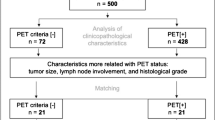Abstract
Introduction
Dynamic positron emission tomography (PET) studies with 2-deoxy-2-[F-18]fluoro-d-glucose (FDG) were performed in patients with advanced nonsmall cell lung cancer (NSCLC) who received palliative chemotherapy to evaluate the impact of full kinetic analysis and assess its value with regard to short or long survival.
Materials and Methods
The evaluation includes 42 metastatic lesions in 14 patients with NSCLC. All patients received a combined chemotherapeutic protocol consisting of vinorelbin and oxaliplatin. The survival data served as reference for the PET data. All patients were examined before onset of chemotherapy and on day 15–21 after onset of the first cycle. The following parameters were retrieved from the dynamic PET studies: standardized uptake value (SUV), fractal dimension, two-compartment model with computation of k1, k2, k3, k4 (unit: 1/min), the fractional blood volume, and the FDG-influx according to Patlak was calculated using the formula (k1 × k3) / (k2 + k3). We used a two-group classification, namely, a short- and long-term survival group based on the median survival time (193 days) as a cutoff. A support vector machines (SVM) analysis was used for classification of the two a prior defined groups.
Results
The observed survival times varied from 40 to 392 days with a median survival time of 193 days. Most kinetic parameters demonstrated only small changes mostly declining after one cycle. The change in all kinetic parameters did not correlate to the survival-based classification. The change in SUV was significant between the first and second study (p = 0.006) but without an impact on the prediction of short or long survival. SVM-based analysis revealed the highest correct classification rate (CCR) between short and long survival for the combination of SUV and influx of the first study and SUV, influx, k2, and k4 of the second study with a CCR of 95.2%.
Conclusion
The results demonstrate that a full kinetic analysis of the FDG kinetics in NSCLC is helpful for the classification into short or long survival and may be used to identify those patients who may benefit from this palliative chemotherapeutic protocol.




Similar content being viewed by others
References
Cancer Research UK. Incidence and mortality in the European Union. Available at: http://info.cancerresearchuk.org
Socinski MA, Morris DE, Masters GA, Lilenbaum R (2003) Chemotherapeutic management of stage IV non-small cell lung cancer. Chest 123:226S–243S
Socinski MA (2001) Chemotherapy for stage IV non-small cell lung cancer. In: Detterbeck FC, Rivera MP, Socinski MA, et al (eds) Diagnosis and treatment of lung cancer: an evidence-based guide for the practicing clinician. Philadelphia, PA: WB Saunders, pp 307–325
Strauss LG, Conti PS (1991) The applications of PET in clinical oncology. J Nucl Med 32:623–648
Burger C, Buck A (1997) Requirements and implementations of a flexible kinetic modeling tool. J Nucl Med 38:1818–1823
Mikolajczyk K, Szabatin M, Rudnicki P, Grodzki M, Burger C (1998) A Java environment for medical image data analysis: initial application for brain PET quantitation. Med Inform 23:207–214
Miyazawa H, Osmont A, Petit-Taboue MC, et al (1993) Determination of 18F-fluoro-2-deoxy-d-glucose rate constants in the anesthetized baboon brain with dynamic positron tomography. J Neurosci Methods 50:263–272
Sokoloff L, Smith CB (1983) Basic principles underlying radioisotopic methods for assay of biochemical processes in vivo. In: Greitz T, Ingvar DH, Widén L (eds) The metabolism of the human brain studied with positron emission tomography. New York: Raven, pp 123–148
Ohtake T, Kosaka N, Watanabe T, et al. (1991) Noninvasive method to obtain input function for measuring glucose utilization of thoracic and abdominal organs. J Nucl Med 32:1432–1438
Dimitrakopoulou-Strauss A, Strauss LG, Burger C, et al. (2003) On the fractal nature of positron emission tomography (PET) studies. World J Nucl Med 4:306–313
Moghaddam B, Yang MH (2000) Gender classification with support vector machines (abstract). In: Proceedings of the 4th IEEE International Conference on Automatic Face and Gesture Recognition, Grenoble, France, pp 306–311
Dimitrakopoulou-Strauss A, Strauss LG (2006) Quantitative studies using positron emission tomography for the diagnosis and therapy planning in oncological patients. Hell J Nucl Med 9:10–21
Weber WA, Petersen V, Schmidt B, et al. (2003) Positron emission tomography in non-small-cell lung cancer: prediction of response to chemotherapy by quantitative assessment of glucose use. J Clin Oncol 21:2651–2657
Couturier O, Jerusalem G, N’Guyen J-M, Histinx R (2006) Sequential Positron emission tomography using (18F)Fluorodeoxyglucose for monitoring response to chemotherapy in metastatic breast cancer. Clin Cancer Res 12:6437–6443
Choi NC, Fischman AJ, Niemierko A, et al. (2002) Dose–response relationship between probability of pathologic tumor control and glucose metabolic rate measured with FDG PET after preoperative chemoradiotherapy in locally advanced non-small-cell lung cancer. Int J Radiat Oncol Biol Phys 54:1024–1035
Freedman NMT, Sundaram SK, Kurdziel K, et al. (2003) Comparison of SUV and Patlak slope for monitoring of cancer therapy using serial PET scans. Eur J Nucl Med 30:46–53
Keiding S, Munk OL, Schiott KM, Hansen SB (2000) Dynamic 2-(F-18)fluoro-2-deoxy-d-glucose positron emission tomography of liver tumours without blood sampling. Eur J Nucl Med 27:407–412
Dimitrakopoulou-Strauss A, Strauss LG, Burger C, et al. (2004) Prognostic aspects of 18F-FDG PET kinetics in patients with metastatic colorectal carcinoma receiving FOLFOX chemotherapy. J Nucl Med 45:1480–1487
Römer W, Hanauske A-R, Ziegler S, et al. (1998) Positron emission tomography in non-Hodgkin’s lymphoma: assessment of chemotherapy with Fluorodeoxyglucose. Blood 12:4464–4471
Dimitrakopoulou-Strauss A, Strauss LG, Rudi J (2003) PET-FDG as predictor of therapy response in patients with colorectal carcinoma. Q J Nucl Med 47:8–13
Strauss LG, Dimitrakopoulou-Strauss A, Haberkorn U (2003) Shortened PET data acquisition protocol for the quantification of 18F-FDG kinetics. J Nucl Med 44:1933–1939
Author information
Authors and Affiliations
Corresponding author
Rights and permissions
About this article
Cite this article
Dimitrakopoulou-Strauss, A., Hoffmann, M., Bergner, R. et al. Prediction of Short-term Survival in Patients with Advanced Nonsmall Cell Lung Cancer Following Chemotherapy Based on 2-Deoxy-2-[F-18]fluoro-d-glucose-Positron Emission Tomography: A Feasibility Study. Mol Imaging Biol 9, 308–317 (2007). https://doi.org/10.1007/s11307-007-0103-6
Published:
Issue Date:
DOI: https://doi.org/10.1007/s11307-007-0103-6




